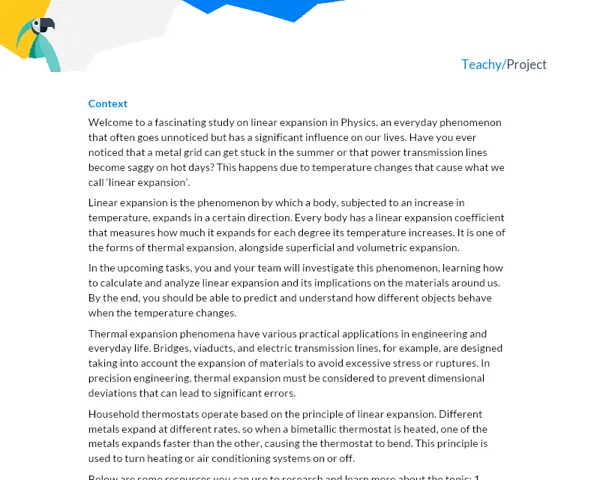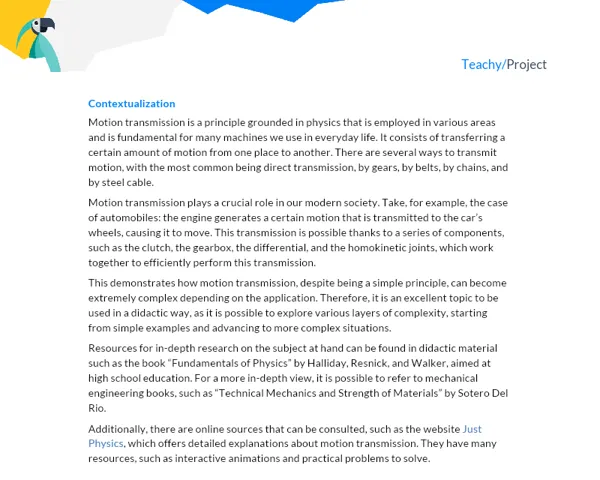Contextualization
The lever is one of the oldest simple machines known to humanity and continues to be one of the most used. Historically, levers were used to move heavy stones in the construction of buildings and monuments, to propel vehicles, and to move heavy loads. Sir Isaac Newton provided the first scientific description of levers in the 17th century, describing them in terms of forces and torques.
Levers are devices that can change the direction of the applied force and multiply its intensity. They are central to many devices and machines we use daily, from the tweezers you use to remove a splinter from your finger, to the door lever you use to enter your house, to the crane we see in constructions. Understanding levers is therefore crucial to understanding the operation of many objects around us.
In theoretical terms, there are three types of levers, each with its mechanism and application. They are: first-class, second-class, and third-class levers. Each type has a fulcrum, a resisting force, and an applied force, distributed in different ways. In first-class levers, the fulcrum is located between the resisting force and the applied force, in second-class levers, the resisting force is between the fulcrum and the applied force, and in third-class levers, the applied force is between the fulcrum and the resisting force.
Introduction
The purpose of this project is to explore levers in all their aspects. We will delve into understanding their theory, the concepts and principles that govern their operation, and their application in the real world. Furthermore, it is important to know the safety precautions associated with the use of levers.
The project is interdisciplinary, involving Physics and Mathematics mainly, but it can also involve other disciplines, such as History, when exploring the origin and use of levers in antiquity. The idea is that learning is practical, carried out in groups, promoting teamwork, effective communication, and time management. We believe that these skills, along with an understanding of the principles of levers, are vital for your academic and personal development.
The reliable sources suggested to base and deepen the theme are:
- Simple Machines: Lever
- What is a lever?
- How levers work
- Levers and their Mathematics
- Book: Physics for High School. Vol. 1. Antônio Máximo and Beatriz Alvarenga.
Practical Activity
Activity Title: "Build, Test, and Apply - A Journey through Levers"
Project Objective
Understand the use and operation of levers in practical and theoretical ways. Develop teamwork skills, problem-solving, effective communication, and time management.
Detailed Project Description
Groups should research, design, build, and test three types of levers: first-class, second-class, and third-class. They should measure and record the applied and resisted forces in each of the levers in order to calculate and understand the mechanical advantage of each. Additionally, they should identify examples of each type of lever in everyday life and discuss their utilities and importance to society.
Required Materials
- Two rectangular wooden boards (approximately 60cm in length)
- Scale (with a capacity of at least 2kg)
- Three broom handles (or similar)
- Various weights (can be stones, books, sandbags)
- Tape measure
- Sawhorses
- Pencil and paper to record results
Detailed Step-by-Step for Activity Execution
- Students should form groups of 3 to 5 people.
- Each group should research and discuss how the three types of levers work, what their differences and similarities are, and identify examples of each type's application in everyday life.
- Then, each group should design and build three types of levers using the available materials.
- For each lever built, students should measure and record the applied force, the resisting force, and the distances between the fulcrum, the applied force, and the resistance.
- Students should calculate the mechanical advantage of each lever and discuss if the results are as expected.
- Finally, each group should prepare a presentation, highlighting what they have learned.
Project Deliverables
After completing the practical activity, each group should prepare a written document in the form of a report, containing:
-
Introduction: The student should contextualize the theme, its relevance and application in the real world as well as the objective of this project.
-
Development: The student should explain the theory behind the central theme(s) of the project, explain the activity in detail, indicate the methodology used, and finally present and discuss the results obtained. In this section, the construction of the levers, the collected data, and the calculations performed to obtain the mechanical advantage should be detailed. It should also comment on examples of levers in everyday life and their relevance.
-
Conclusion: The student should conclude the work by summarizing its main points, explaining the learnings obtained, and drawing conclusions about the project.
-
Bibliography: The student should indicate the sources they relied on to work on the project such as books, web pages, videos, etc.
The estimated duration for the total execution of the project is more than 12 hours per participating student.



